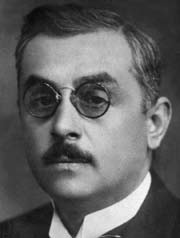Celâl Bayar facts for kids
Quick facts for kids
Celâl Bayar
|
|
|---|---|
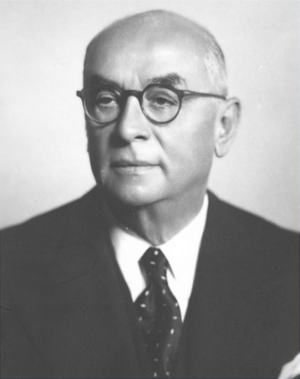
Bayar c. 1950s
|
|
| 3rd President of Turkey | |
| In office 27 May 1950 – 27 May 1960 |
|
| Prime Minister | Adnan Menderes |
| Preceded by | İsmet İnönü |
| Succeeded by | Cemal Gürsel |
| 3rd Prime Minister of Turkey | |
| In office 1 November 1937 – 25 January 1939 |
|
| President | Mustafa Kemal Atatürk Abdülhalik Renda (Acting) İsmet İnönü |
| Preceded by | İsmet İnönü |
| Succeeded by | Refik Saydam |
| Leader of the Democrat Party | |
| In office 7 June 1946 – 9 June 1950 |
|
| Preceded by | Position established |
| Succeeded by | Adnan Menderes |
| Member of the Grand National Assembly | |
| In office 28 June 1923 – 14 May 1950 |
|
| Constituency | Izmir (1923, 1927, 1931, 1935, 1939, 1943, 1946) Istanbul (1950, 1954, 1957) |
| Personal details | |
| Born |
Mahmud Celâleddin
16 May 1883 Gemlik, Ottoman Empire |
| Died | 22 August 1986 (aged 103) Istanbul, Turkey |
| Political party | Democrat Party (1946–1961) Republican People's Party (1923–1945) Committee of Union and Progress (1908–1922) |
| Spouse | Reşide Bayar (1886–1962) |
| Relations | Ahmet İhsan Gürsoy (son-in-law) |
| Children | 3, including Nilüfer |
| Signature | |
Mahmud Celâleddin "Celâl" Bayar (1883–1986) was an important Turkish leader. He served as the third President of Turkey from 1950 to 1960. Before that, he was the Prime Minister of Turkey from 1937 to 1939.
Bayar started his career in a group called the Committee of Union and Progress. He helped set up its branches in Izmir and Bursa. After Turkey became a republic, he helped create many early financial organizations. This included Turkey's first national bank, İş Bankası. He believed in free markets. Because of this, Mustafa Kemal Atatürk made him prime minister in 1937. He aimed to make the economy more open. He resigned in 1939 after Atatürk passed away.
In 1946, he started the Democrat Party. This marked the beginning of Turkey having more than one political party. In 1950, his party won the elections. Bayar became Turkey's third president. He was re-elected in 1954 and 1957, serving for 10 years. He was removed from power after a military takeover in 1960. Celâl Bayar lived to be 103 years old, making him one of the longest-living former heads of state.
Contents
Who Was Celâl Bayar?
His Early Life and Education
Mahmud Celâleddin was born on May 16, 1883. His family lived in a village called Umurbey, near Gemlik, Turkey. His father was a religious leader and teacher. After finishing school, Bayar worked as a clerk. He first worked in a court in Gemlik. Later, he worked at Ziraat Bank and Deutsche Orientbank.
Joining the Committee of Union and Progress
In 1907, Bayar joined a group called the Committee of Union and Progress (CUP). He helped set up new local branches of this group. He worked to organize their activities in Anatolia. Bayar also started a newspaper called Halkın Doğru (True to the People). In this paper, he wrote articles supporting the CUP. He used the pen name Turgut Alp.
Bayar was good with money matters. He played a role in the CUP's economic plans. He also helped open schools and a library in İzmir. He was involved in creating the sports club Altay S.K.
Celâl Bayar and Turkey's Independence
Fighting for Freedom
After World War I, parts of the Ottoman Empire were occupied. Bayar helped create groups to defend Turkey's rights. He formed the "Association for the Cancellation of İzmir's Annexation." He also helped create the "Association for the Defence of Ottoman İzmir."
When İzmir was occupied, Bayar joined the national resistance fighters. He fought against the occupying forces. He was elected to the Ottoman Parliament in 1919. He spoke out against the government's lack of action.
Joining Mustafa Kemal Atatürk
After the occupation of Istanbul, Bayar went to Ankara. He joined Mustafa Kemal Atatürk and the Turkish Independence Movement. He became a representative for Bursa in the new Grand National Assembly of Turkey.
He served as a deputy minister of the economy in 1920. In 1921, he became the minister of the economy. Bayar was also part of the Turkish team at the Lausanne Peace Conference in 1922. This conference helped set the borders of modern Turkey.
Celâl Bayar in the One-Party Era
Shaping Economic Policy
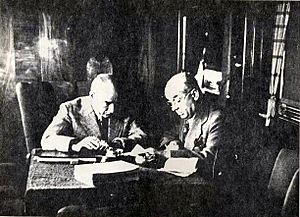
In 1923, Bayar was elected as a representative for İzmir. His group, the Association for the Defence of National Rights, became the Republican People's Party (CHP). This party was the only legal party in Turkey for a long time.
In 1924, Atatürk asked Bayar to create a national bank. This led to the founding of İşbank in Ankara. This bank used money sent by Muslims in India to support Turkey's independence. Bayar helped guide Turkey's economic plans. He supported a modern, state-backed economy.
Becoming Prime Minister
Bayar became a strong supporter of state-led economic growth. He believed the government should play a big role in the economy. During his time as economic minister, industries grew a lot. The First Five-Year Industry Plan was created. New institutions like Sümerbank and Etibank were set up to help industries.
On November 1, 1937, Atatürk made Bayar the Prime Minister of Turkey. He continued to serve as prime minister after Atatürk died in 1938. However, he had different ideas from the new president, İsmet İnönü. These differences led him to resign on January 25, 1939.
Starting the Democrat Party
A New Political Path
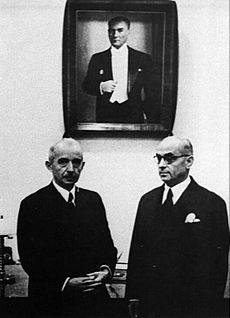
During World War II, Bayar was a member of parliament but not in the government. After 1943, he started to disagree with the government.
After the war, there was a global push for more democracy. Bayar, along with Adnan Menderes, Fuat Köprülü, and Refik Koraltan, asked for changes to the party's rules. They wanted more political freedom in the country. Their ideas were rejected by the CHP.
Because of this, Köprülü and Menderes were removed from the CHP. Bayar resigned from parliament and the CHP in 1945. On January 7, 1946, these four leaders founded the Democrat Party (DP). Bayar was chosen as its leader. The DP wanted more open economic policies and less government control.
Success in Elections
The Democrat Party did well in the 1946 election. They won 62 seats in parliament. Bayar was elected as a representative from Istanbul. Between 1946 and 1950, he led the opposition against the CHP.
At the DP's first meeting in 1947, Bayar asked for changes to election laws. He wanted the president not to be the head of a political party at the same time. The DP was supported by religious groups who wanted less strict secular policies. Bayar's background helped assure people that the party would still respect secularism.
Celâl Bayar as President
Leading Turkey
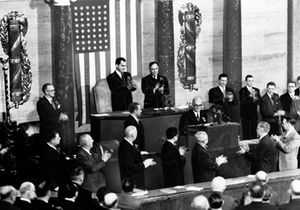
In the first truly free elections in Turkey's history, the Democrats won in 1950. They received 53% of the votes. On May 22, 1950, parliament elected Bayar as president of Turkey. He then stepped down as DP leader. He was the first president of Turkey who did not come from a military background.
He was re-elected in 1954 and 1957. He served as president for 10 years. During his time, Adnan Menderes was his prime minister.
International Relations and Changes in Turkey
During Bayar's presidency, Turkey's relations with Western countries improved. After a crisis with the Soviet Union, Turkey joined the Korean War in 1951. Then, in February 1952, Turkey joined NATO. Bayar was the first Turkish president to visit the United States in 1954. He once said that Turkey would become a "Little America" in 30 years.
During the Democrat Party's 10 years in power, Turkish society changed a lot. The economy encouraged private businesses. More people from different parts of Turkey became involved in politics and business. While secularism remained, the very strict secular policies of the past were relaxed.
Overthrow and Later Life
The 1960 Coup
On May 27, 1960, the military took control of the government. This was known as the 1960 coup d'état. Bayar tried to resist the officers who came to arrest him. He was arrested along with other Democrat Party members.
He was put on trial and sentenced to death in 1961. However, his sentence was changed to life imprisonment. He was moved to Kayseri Prison.
Release and Return to Public Life
Bayar was released from prison on November 7, 1964, due to his health. He was later pardoned by President Cevdet Sunay in 1966. A new law in 1966 freed all former Democrat Party members.
After being pardoned, Bayar worked to get back the political rights of former DP members. In 1968, he started a club called Bizim Ev (Our Home). This club brought together former Democrats. He met with his old rival, İnönü, in 1969. This meeting helped lead to a change in the constitution. This change gave back political rights to former DP members.
Bayar's full political rights were restored in 1974. He was offered a lifetime seat in the Senate, but he declined. He believed people should only represent others if they are elected. He supported the military government in 1980 and the 1982 Constitution.
Final Years and Legacy

Celâl Bayar turned 100 years old on May 16, 1983. He passed away on August 22, 1986, in Istanbul. He was 103 years old. There was a discussion about burying him in Anıtkabir, a special memorial site. However, he was buried in his hometown of Umurbey after a state ceremony.
Bayar received several awards during his life. In 1954, he received the Grand Cross Special Class of the Order of Merit from Germany. He also received the Legion of Merit Award from the United States for Turkey's role in the Korean War. He was given honorary doctorates from the University of Belgrade and Freie Universität Berlin. The Celal Bayar University, founded in 1992, is named after him.
His Family
Celâl Bayar married Reşide in 1904. They had three children: Refii, Turgut, and Nilüfer. His daughter, Nilüfer Gürsoy, married Ahmet İhsan Gürsoy. Ahmet was also a politician and served as a deputy in parliament.
Images for kids
-
Mustafa Kemal Atatürk and Bayar on November 12, 1937
-
İsmet İnönü and Bayar in 1938
-
President Bayar receives a standing ovation after his speech before a joint session of Congress. Behind him are Vice-President Nixon and Speaker of the House Sam Rayburn (1954).
-
Bayar during a state visit to West Germany in 1958
See also
 In Spanish: Celal Bayar para niños
In Spanish: Celal Bayar para niños


